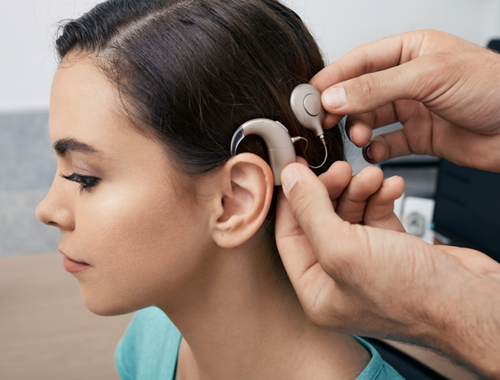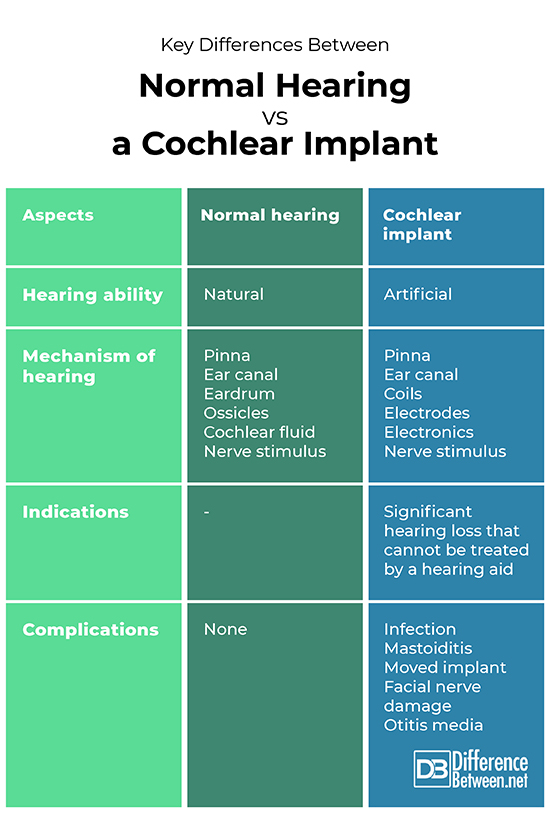Difference Between a Cochlear Implant and Normal Hearing
A cochlear implant (CI) is a surgically implanted neuroprosthesis (neurological device) that provides a person who has a type of hearing loss a new level of sound perception.
With the help of therapy, cochlear implants can even result in improved speech understanding in both quiet and noisy environments. Normal hearing depends on the ear canal to be patent and the nerves to be functional. Cochlear implants are only useful in cases where the nerves are not functioning properly and not in cases of physical/mechanical hearing loss.

Normal Hearing
In a person with normal hearing, a sound will enter the outer ear, commonly known as the pinna or auricle which has a funnel-like shape.
When sound reaches the pinna, it acts as a filter which then amplifies the travelling sound waves along and into the ear canal. The sound waves then go on to hit the eardrum (known as the tympanic membrane) and makes it vibrate. The middle ear is behind this eardrum, and this is where waves are amplified before they move deeper into the inner ear.
The eardrum is attached to a chain of three small bones known as the ossicles. When the
eardrum vibrates because of the sound waves these bones start moving. The malleus is connected to the incus. The incus is attached to the stapes bone. This last bone (the stapes) which is connected to a membrane separating the middle ear from the inner ear (known as the oval window).
The way in which the three bones are structures allows them to function as a lever which amplifies the sound energy as it moves from the eardrum to the small oval window.
Finally, the vibrations from the stapes push on the oval window which results in pressure waves travelling into the fluid-filled cochlea that contains the organ of Corti. In the organ of Corti, vibrations are finally transformed into electrical energy by hair cells (also referred to as stereocilia).
Brain cells (sensory neurons) finally function to transmit the sound information to targeted areas in the brain.

Cochlear Implant
Cochlear implantation has become a global routine procedure to combat certain hearing loss.
A cochlear implant contains two main components. The outside component, which is carried and worn behind the ear, or could also be attached to clothing in the case of active or young children. This component is known as the sound processor and comprises electronics that process digital signals, a battery, and a coil that carries signals to the implant from the skin.
The inside component contains a coil to which receives signals, has electronics and numerous electrodes which occur in the cochlea and stimulate the cochlear nerve.
Surgical implantation
Implantation is modern and referred to as a mastoidectomy with facial recess approach (MFRA), and most people receiving them can leave the same day. The procedure is associated with few surgical complications.
Complications
The procedure is usually done under a type of general anaesthesia. Complications are rare but can occur. These include mastoiditis, otitis media, moved implanted device needing repair, damaged facial nerve, and infections. Cochlear implantation is seen as a safe procedure with an infection rate of around 3%.
Indications
The main indication for cochlear implantation is significant hearing loss that cannot be treated with standard hearing aids.
Key differences between normal hearing and a cochlear implant

Summary
Cochlear implants are phenomenal and help provide people with severe hearing loss an
opportunity to regain a degree of normal hearing. It does not restore hearing completely but
can potentially increase and improve the patient’s quality of life immensely. It is a decision that should be made in collaboration with your doctor and specialists to ensure the best possible outcome for the future.
Frequently asked questions
How is hearing with a cochlear implant different from normal hearing?
Hearing through a cochlear implant is different from normal hearing and takes time to learn or relearn the new sounds. It allows many people to recognize warning signals that may be missed and understand other sounds in the environment.
Is a cochlear implant better than a hearing aid?
Hearing aids are the technological device most chosen in the case where people have hearing loss, but for those who are deaf or severely hard of hearing, cochlear implants may be a much better option and solution to the problem.
In other words, the two are used for different types of hearing loss and when they are indicated they are the best suited choice.
How is sound different with a hearing aid?
Some patients describe the sound in their hearing aid as very metallic and then others describe the very same sound as clinical. Some people really enjoy the sounds, while others find it to be uncomfortable and quite unpleasant. It is difficult to find words for describing the perception of sounds, as sound perception is very subjective to those who experience it themselves.
What are the disadvantages of a cochlear implant?
Cochlear implants themselves can be very expensive and the procedure too. Moreover, cochlear implants need invasive surgery with the risk of certain complications.
It’s important to stay realistic and realize that cochlear implants do not restore hearing, they give a sensation of sound, so there is a long learning curve and it will take time to start understanding and interpreting what the new signals mean to them.
Can I hear after a cochlear implant?
Cochlear implants allow deaf people to now receive, and process sounds and speech. That being said, these cochlear implant devices do not restore normal hearing as experienced by a person of normal hearing.
- Difference Between a Cochlear Implant and Normal Hearing - October 4, 2022
- Difference Between Obstructive and Restrictive Spirometry - September 11, 2022
- The Difference Between White Box and Black Box Testing - September 11, 2022
Search DifferenceBetween.net :
Leave a Response
References :
[0]Hear-it. What does your hearing aid sound like? https://www.hear-it.org/what-does-your-hearing-aid-sound-like-
[1]National Institute on Deafness and Other Communication Disorders. How Do We Hear? https://www.nidcd.nih.gov/health/how-do-we-hear
[2]National Institute on Deafness and Other Communication Disorders. Quick Statistics About Hearing. https://www.nidcd.nih.gov/health/statistics/quick-statistics-hearing
